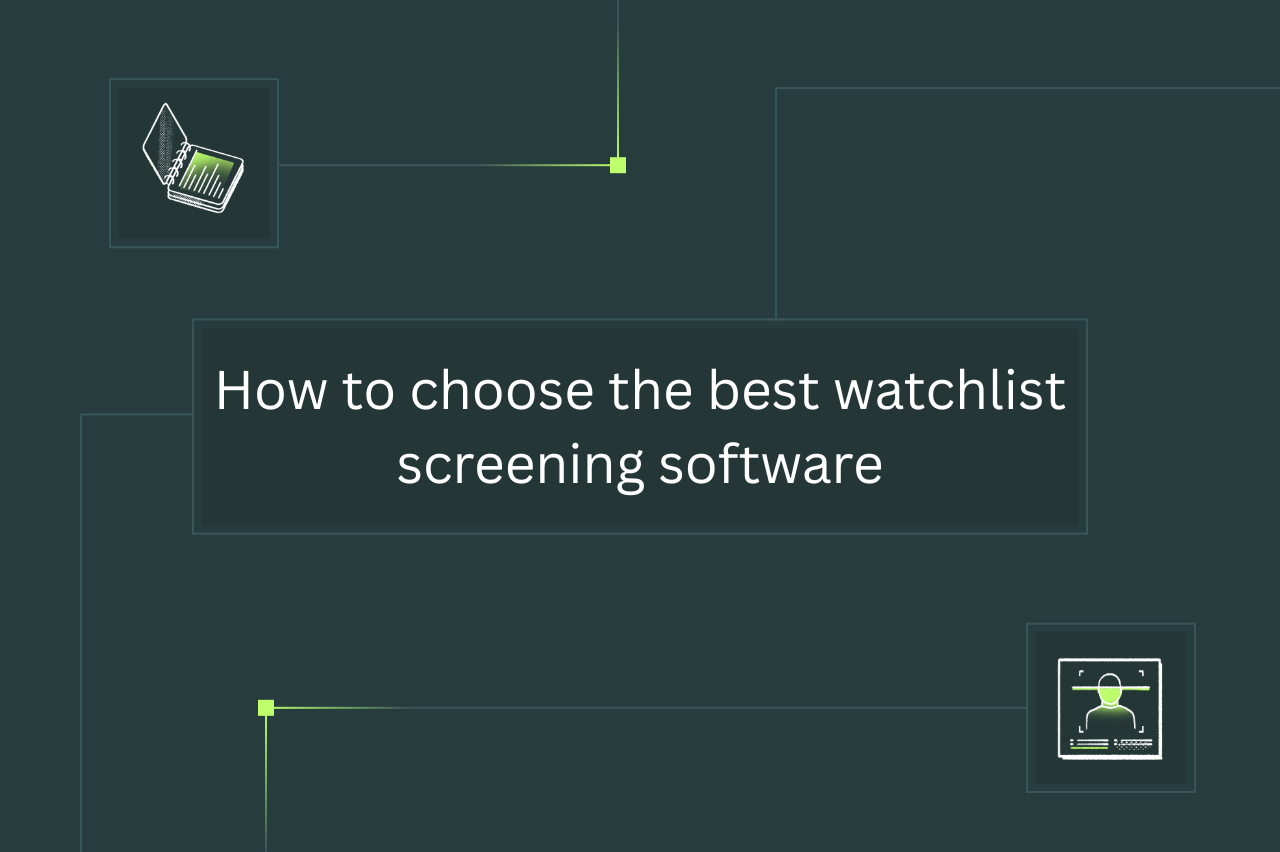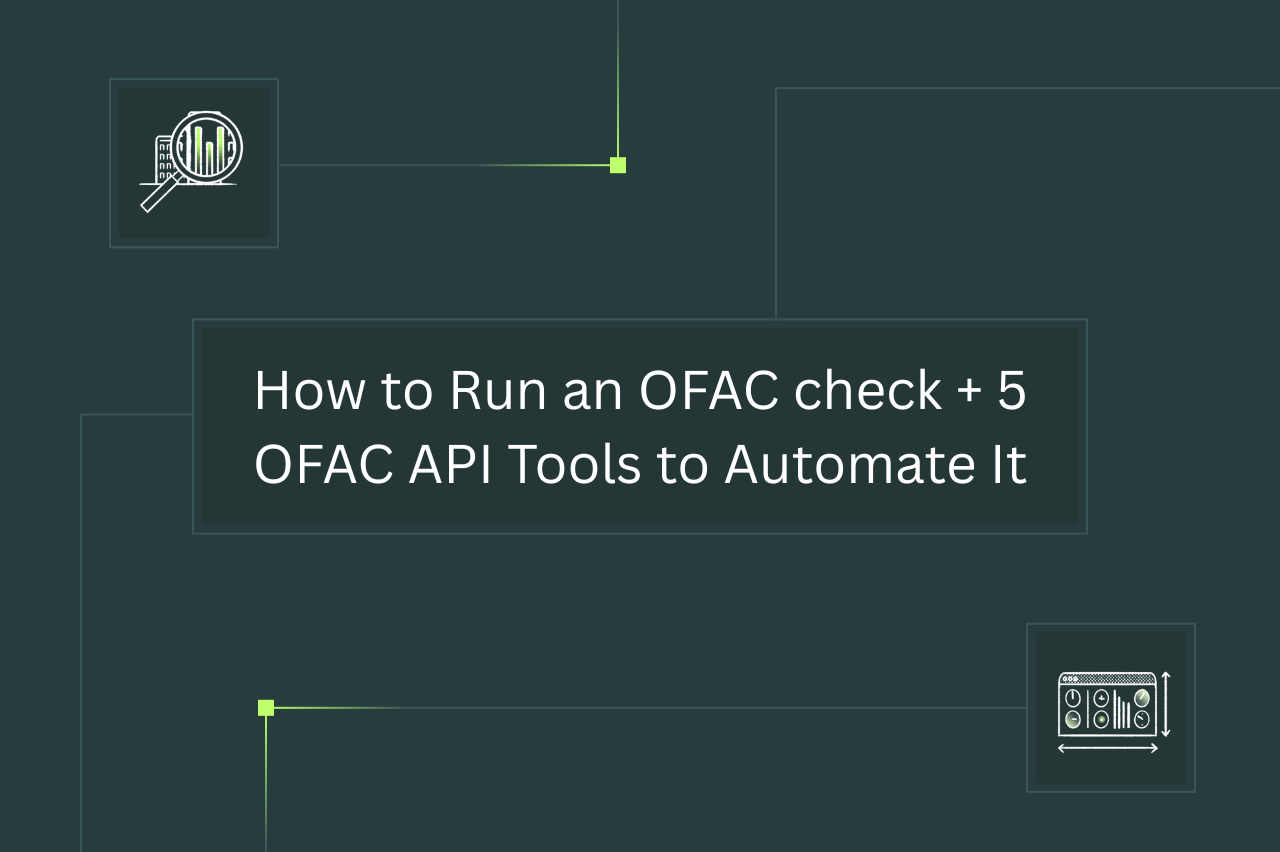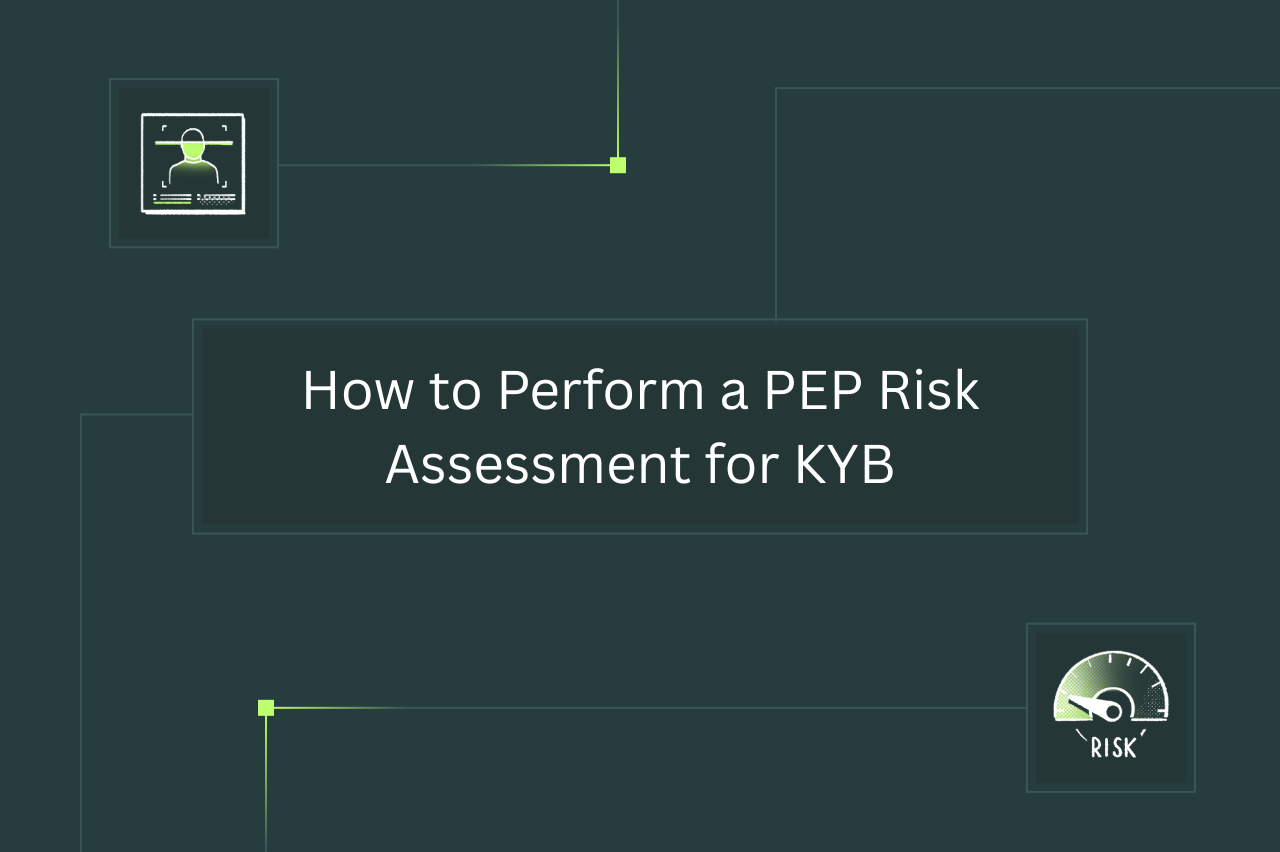In brief:
- Watchlist screening software is a requirement for KYB that automatically determines if a business – or associated person or country – is on a sanctions list, wanted list, PEP list, or other watchlist. This, in turn, tells an organization if that entity is high-risk or even illegal to have a relationship with.
- Watchlist screening software helps streamline B2B/B2C onboarding and relationship management. Its automation capabilities help organizations comply with regulations and properly assess risk, all while staying agile and conserving resources.
- Watchlist screening software is used to draw data from official (or at least reliable) sources, match names despite variations in spellings or formats, prioritize alerts, manage cases, and document actions taken (for auditing purposes).
National and international regulatory organizations sometimes place people, groups, or countries/territories on watchlists. This indicates that, because of criminal or otherwise dangerous behavior, these entities are risky or even outright illegal to deal with. When onboarding or managing relationships with clients or partners, organizations need to heed these lists as part of their business verification due diligence.
But there are many watchlists that can be relevant to an organization, and each one can have hundreds or thousands of entities listed on it. Checking all of an organization’s clients and partners against these watchlists one-by-one just isn’t efficient. That’s why many organizations use software solutions to automate watchlist screening.
In this article, we advise on how an organization can pick the right watchlist screening software for its needs.
- What is watchlist screening software?
- Why watchlist screening software is important
- What types of watchlists do you need to screen against?
- How to choose the right watchlist screening software
- 5 best watchlist screening solutions
First, we explain a bit more about what watchlist screening software is, including why organizations with formal clients and partners should be using it.
“Watchlist”, when used in this context, is a bit of a catch-all term. It refers to any list published by a national or international regulatory body that designates individuals, groups, or territories as being illegal or at least high-risk to deal with.
Some watchlists completely prohibit having commercial relationships with specified people, groups, or territories. Usually, this is because of prior or ongoing criminal (or at least unethical) activity.
Others may list people, groups, or territories that aren’t necessarily illegal to deal with. However, they note that the listed entities may still be at a high risk for getting (or being) involved in crime or other unethical activity because of their circumstances.
Some of the watchlists Middesk screens against include:
- OFAC’s Specially Designated Nationals (SDN) list
- BIS’s Denied Persons List (DPL)
- State Department’s International Traffic in Arms Regulations (ITAR) Debarred list
{{related-content-block="/blog/how-to-run-an-ofac-check"}}
Watchlist monitoring is important for organizations starting (or continuing) relationships with entities as clients or partners, from both regulatory compliance and risk assessment standpoints.
In terms of regulatory compliance, an organization needs to ensure it isn’t breaking the law by dealing with a person, group, or territory that has been sanctioned or is (suspected of being) involved in crime. On the risk assessment side, an organization needs to know why that entity may be more or less likely to get (or already be) involved in unethical or illegal activity.
The main issue with this, however, is one of scale. Organizations can have hundreds or thousands of individuals and businesses as clients or partners, or as ultimate beneficial owners of businesses. To ensure they don’t work with prohibited businesses or individuals, each needs to be screened against watchlists, not only at onboarding but also throughout the client or partner lifecycle (in case an entity is added to or removed from a watchlist during a relationship).
Whenever brands look towards watchlist and KYB data, they need to ensure they are relying on vendors that get current, fresh data from authoritative sources, and that your watchlist screening program is keeping up with the constant regulatory changes in the world of AML. Our webinar below can help with that:
{{gated-content-block="/events/webinar-fincens-aml-changes-sep-2024"}}
There are several types of watchlists that can indicate a business—or a person involved with a business—is risky or even illegal to associate with. Here are a few standard ones.
Sanctions lists
These list people, groups, and territories that national or international governing agencies have prohibited dealings with. Usually, entities are on this list because they have committed serious crimes or other behavior dangerous to a nation or the international community. Examples include money laundering, terrorism, military aggression, commodity smuggling, human trafficking, or weapons of mass destruction proliferation.
Organizations need to avoid having relations with any entity on a sanctions list, or they can face severe criminal penalties. In the US, most sanctions lists are administered by the Office of Foreign Assets Control (OFAC).
Criminal records & wanted lists
Organizations should check people, whether potential individual clients or owners associated with potential client or partner businesses, for past illegal activity. Said activity may even be a relevant threat to an organization’s operations. For example, financial institutions might be especially concerned about individuals with histories of theft, fraud, or money laundering.
Some individuals may not have been charged with a crime in the past, but are currently suspected of committing one. So an organization should check criminal wanted lists to ensure it isn’t associating with one of these people. Otherwise, it can suffer reputational damage from being tied to a wanted criminal, or even be implicated in the suspect’s activities.
Politically exposed persons (PEP) lists
Politically exposed persons (PEPs) are people who occupy highly-influential administrative positions. This means they have more opportunities to commit crimes, and can cause greater disruptions if they do. Consequently, they are also more attractive targets for criminals to extort.
PEPs are considered high-risk individuals, and need to be vetted carefully before an organization enters or continues a relationship with them, or with a business they’re involved in.
Watchdog watchlists
Some watchdog organizations (or government agencies), such as the Financial Action Task Force (FATF), publish their own watchlists. These may list certain countries or territories as elevated or serious risks, based on how much illegal or unethical activity is happening there and how much the local government is doing to stop it.
These watchlists usually aren’t legally binding to make dealing with a jurisdiction—including businesses and people within it—a crime. However, many are drafted by well-respected organizations and followed as standards by multiple countries. So they’re usually good indicators of where an organization should be cautious when looking for clients or business partners.
Adverse media coverage
Though not technically “watchlists” per se, other information sources an organization might want to screen include trustworthy news outlets. These might provide preliminary indicators that a business, or person behind a business, is involved in unlawful or unethical activity.
Note that negative press isn’t always rock-solid proof that anything untoward is going on with a person or business. However, it can be an early warning sign that an organization might be taking on reputational (and other) risks by associating with that entity. To mitigate against this risk, many businesses conduct adverse media screening to add an additional layer of protection.
So how does an organization find the right watchlist software to cover all of this information? We discuss that in the next section.
There are two major considerations for an organization when choosing watchlist screening software:
The first is which watchlists are relevant to the organization. Some, like sanctions lists and criminal wanted lists, are broadly applicable and relevant in all cases. Others may only be relevant to specific industries, or based on an organization’s expected clientele. An organization may need global watchlist screening, or only screening for a specific geographical area. An organization may also choose to screen some lists and not others based on its risk appetite and/or available resources.
The second consideration is how well the software’s features can meet the organization’s screening needs. Where does it source data from? How precisely can it match names? What are its case management capabilities like? Does it record a history of alerts and actions, or allow for creating custom internal lists? How well does it scale if the organization grows? These are all factors that will need to be taken into account when choosing the right solution for your organization.
Top 5 features to look for in a watchlist screening software
Below, we cover the top five features an organization should ask about when shopping for a watchlist monitoring solution.
- Integration with trusted sources: Ideally, watchlist screening software should be able to pull data directly from the agencies issuing the watchlists. This helps to ensure an organization is screening in real time against the most up-to-date data, and cross-checking multiple sources to avoid potential oversights.
- Name matching tools: Names can sometimes be tricky to match. There can be spelling variations, typos, aliases, or alternate orders of given and family names. Good watchlist screening solutions will have algorithms—perhaps even powered by machine learning—that can match names by similar spellings and/or phonetic pronunciations.
- Alert scoring: Not every name match against a watchlist means the same thing to an organization. Some will be people, businesses, or countries that an organization should absolutely stay away from. Others are entities that may pose elevated risks, but could still be safe to associate with if the organization’s risk appetite allows for it. Top-end watchlist screening software will allow an organization to set its risk tolerances, and then prioritize alerts based on those parameters.
- Operations documentation: Besides actually searching watchlists for matches, another compliance-related function watchlist screening software should have is to show it’s working. That includes automatically making records of updates, alerts, cases opened, and actions taken within the system. This is not only useful for internal audits of how well an organization’s client/partner onboarding and management processes are working. It’s also an essential step in proving to regulators that the organization is complying with KYB/KYC standards.
With all of this said, there are many software solutions out there that screen watchlists as part of broader Anti-Money Laundering (AML) and Countering the Financing of Terrorism (CFT) applications. So which one(s) should an organization start looking at to get a baseline for its performance and feature requirements? We’ll offer some suggestions next.
Here are six highly-recommended AML/CFT software providers that offer watchlist screening as part of their services.
1. Middesk
Middesk checks people and groups against 15 key US sanctions lists and other watchlists. It also has features such as date of birth filtering, fuzzy name matching, and the ability to run searches against specific watchlists. Middesk pulls information directly from government sources daily, so you’re sure to get fresh and accurate data.
In addition to screening for watchlist hits, Middesk also returns other potential risk indicators for businesses. These include industry classifications, adverse media coverage, web presence, litigations, bankruptcies, liens, and more. With all the information you need in one place, you can effectively assess the risk of new clients and onboard them with ease.
2. Dow Jones Risk & Compliance
Known mainly for its financial data, Dow Jones also has a solution for checking people and groups against watchlists. Dow Jones’s watchlist screening also features tools for risk assessment and continuous monitoring. In addition, the company has a tool called Factiva for checking for adverse media coverage on entities.
Though this solution is feature-rich, it may be overwhelmingly so for smaller businesses that aren’t working in several highly-regulated industries at once. It’s also one of the more expensive options, especially considering the Factiva tool has to be purchased separately.
3. Ondato
Ondato specializes in photo-based and video-based identity verification, though it allows for manual verification as well. As part of this service, it also includes checking the identities of people and groups against watchlists, including sanctions lists and adverse media coverage.
In addition, Ondato has plenty of other features that can be added on to beef up its compliance-enhancing capabilities. However, Ondato’s pricing system is somewhat complex, and its data coverage is limited in some regions.
4. LSEG Data & Analytics
Previously owned by Thomson Reuters and known as Refinitiv World-Check, the London Stock Exchange Group now offers this financial information platform. Part of its capabilities include screening watchlists by cross-checking against millions of customer records for PEP, RCA, or sanctioned statuses. It also has features for searching for and monitoring adverse media coverage.
Like Dow Jones’s watchlist monitoring tool, it may have more features than most small or medium-sized businesses will need. It’s also similarly pricey.
5. Oracle Financial Crime and Compliance Management
Software giant Oracle provides watchlist screening capabilities through its Financial Crime and Compliance Management tool. A cloud-based, full-service anti-financial crime platform, the FCCM software provides a number of useful features for screening watchlists. These include data pre-preparation, advanced name matching algorithms, risk prioritization, real-time screening, and auto-documenting of screening rules configurations for auditing purposes. This wealth of features comes with high hardware, expertise, and budget demands, however.
Middesk’s Business Verification tool checks all major US watchlists—straight from government sources, and updated daily—for businesses and their ultimate beneficial owners. That way, your organization can get timely and accurate notification as to whether a business (or a person who owns it) is high-risk or even illegal to deal with.
This way, you know you’re always following watchlist screening best practices and meeting all AML compliance requirements. This means conducting OFAC screening with software to ensure no sanctions apply to the individuals or business you’re onboarding, as well as prohibited business screening to make sure you maintain the standards you’ve set for yourself.
Beyond that, it can also fetch other risk-indicating information about a business: industry classification, adverse media coverage, web presence, litigations, bankruptcies, and more.
Schedule a demo and get in touch with our sales team to find out exactly how Middesk can save you time and resources while conducting more efficient, accurate watchlist screening.












